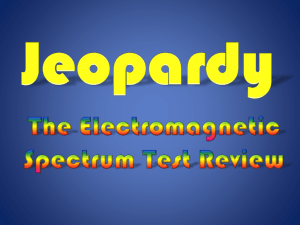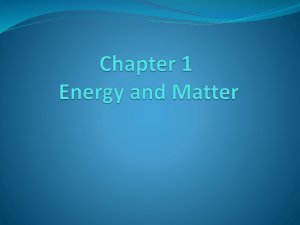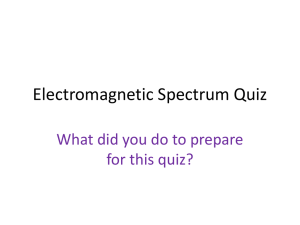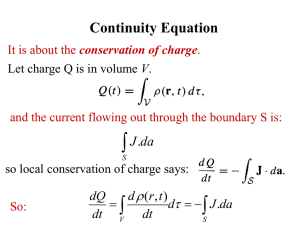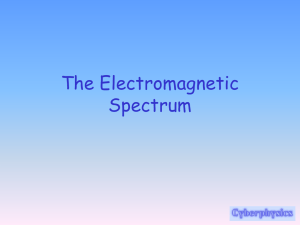Lecture Notes
advertisement
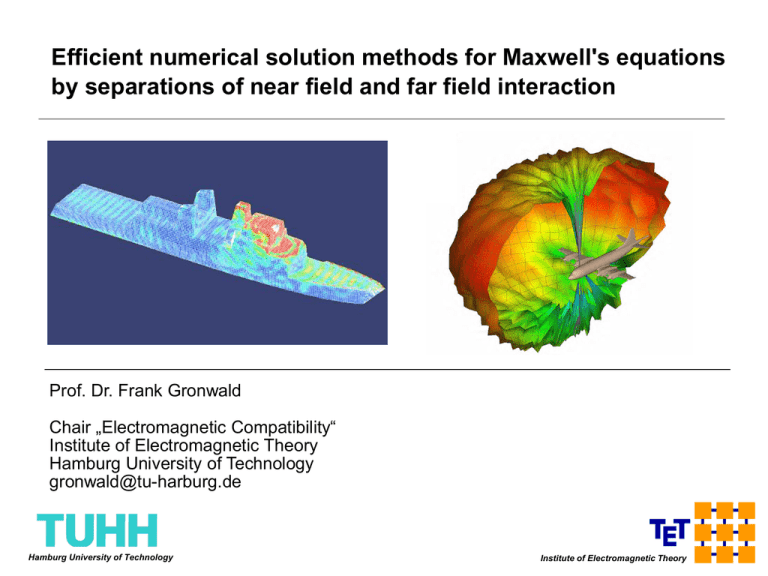
Efficient numerical solution methods for Maxwell's equations by separations of near field and far field interaction Prof. Dr. Frank Gronwald Chair „Electromagnetic Compatibility“ Institute of Electromagnetic Theory Hamburg University of Technology gronwald@tu-harburg.de Hamburg University of Technology Institute of Electromagnetic Theory The Institute of Electromagnetic Theory at the University of Technology Hamburg (TUHH) around 1930 Prof. Dr. Christian Schuster Chair “Electromagnetic Theory” Hamburg University of Technology today Dr. Heinz-D. Brüns Senior Scientist “Numerical Field Computation Frank Gronwald aerial view Prof. Dr. Frank Gronwald Chair “Electromagnetic Compatibility” Transparency 2 Institute of Electromagnetic Theory Overview of the talk 1. Introduction and Motivation: Electromagnetic Engineering Applications and Numerical Field Computation 2. Aspects of efficient numerical field computation in electromagnetic theory 3. Electromagnetic near fields and far fields (Coulomb fields and radiation fields) 4. Separations of near field and far field interactions 5. – Method of analytical regularization – Hybrid representations of Green‘s functions – Multilevel Fast Multipole Algorithm Conclusion Hamburg University of Technology Frank Gronwald Transparency 3 Institute of Electromagnetic Theory 1. Introduction and Motivation - interference analysis of avionic systems transmitting antennas receiving antennas interference matrix some important avionic systems : TCAS = Traffic Collision Avoidance System ATC = Air Traffic Control GPS = Global Positioning System SATCOM = Satellite Communication ADF = Automatic Direction Finder VOR = VHF Omnidirectional Radio Range DME = Distance Measuring Equipment ILS = Instrument Landing System Hamburg University of Technology Frank Gronwald common avionic systems operate in the frequency range 100 kHz to 15 GHz corresponding wavelengths are in the range of 3 km to 2 cm analysis of (unwanted) antenna couplings requires to calculate both near and far fields necessity to numerically solve large scale electromagnetic boundary value problem to obtain interference matrix Transparency 4 Institute of Electromagnetic Theory 1. Introduction and Motivation – interior problems of Electromagnetic Compatibility a low cost electronic power meter complex electric/electronic systems contain various electric/electronic components which might interfer with each other electromagnetic coupling between various electric/electronic components needs to be analyzed and estimated electromagnetic coupling often takes place within a resonating environment (e.g. within a metallic housing, as given by common computer housings) Hamburg University of Technology Frank Gronwald on a more abstract level: modelling of antenna coupling within a cavity antennas carry electric charges and currents that generate electric and magnetic near fields cavity supports electromagnetic modes that correspond to free electromagnetic (far) fields (i.e., solutions of sourceless Helmholtz equations) necessity to solve electromagnetic boundary value problem with near and far field characteristics Transparency 5 Institute of Electromagnetic Theory 2. Aspects of efficient numerical field computation in electromagnetic theory Usually, the solution f of an electromagnetic boundary value problem is given by an element of an infinite dimensional function space (such as a Hilbert or Soboloev space): f n fn n 1 Remark: Often the explicit solution for f is found as the solution of a linear operator equation, see, e.g.: Hanson, G.W. and Yakolev, A.: Operator Theory for Electromagnetics, (Springer, New York, 2002). A numerical solution is a finite approximation f of the form ~ N ~ ~ f f n f n with numerically calculated coefficients ~ n 1 n An efficient numerical solution requires: number N of approximating basis functions fast numerical calculation of the coefficients Hamburg University of Technology Frank Gronwald ~ f n not too large ~n Transparency 6 Institute of Electromagnetic Theory 2. Aspects of efficient numerical field computation in electromagnetic theory ~ Important observation: Basis functions f n that are suitable to approximate a near field (=Coulomb field) often are not suitable to approximate a far field (=radiation field) and vice versa This observation is illustrated by the complementary properties of „rays“ (propagator functions) and „modes“ (eigenfunctions of a compact and self-adjoint operator) that both are often used as approximating basis functions (Felsen, 1984): Rays Modes Scattering processes yield local information of a system Oscillations yield global infornation of a system Characterize early response in time domain Characterize late response in time domain Advantageous for high-frequency regime where the mode-density is high and rays of geometrical optics characterize the field Advantageous for low-frequency regime where the mode-density is low and a small number of modes characterizes the field Advantageous to model Coulomb singularities Advantageous to model resonances It follows that in order to numerically solve electromagnetic boundary value problems it is often necessary to separately analyze near field and far field interactions in order to find approximating basis functions which are suitable to approximate both near fields and far fields Note: Efficient numerical computation schemes often are necessary because computer memory and computation time are limited. Hamburg University of Technology Frank Gronwald Transparency 7 Institute of Electromagnetic Theory 3. Electromagnetic near fields and far fields - fields generated by a point charge 2 q er ',r 1 q E (r , t ) 3 2 4 0 1 er ',r | r r ' | 4 0 ret near field (Coulomb) far field (radiation) e e e r ',r r ',r r ',r 3 2 c 1 e | r r ' | r ', r ret near field (Coulomb) Hamburg University of Technology e e r ',r r ',r 3 c 1 er ',r | r r ' | ret 2 q er ',r 1 q B(r , t ) 3 2 4 0 c 1 er ',r | r r ' | 4 0 ret Advantage: Near field and far field contributions can be written as separate terms Disadvantage: Motion of point charge must be known Disadvantage: Model of point charge not useful for most engineering applications where charge and current distributions are needed far field (radiation) Frank Gronwald Transparency 8 Institute of Electromagnetic Theory 3. Electromagnetic near fields and far fields - fields generated by continuous sources r r' J observer Advantage: Near field and far field contributions can be written as separate terms charge and current distribution E (r , t ) d 3r ' r r' 1 r r ' 1 3 (r ' , t 'ret ) J (r ' , t 'ret ) (r ' , t 'ret ) d r ' 4 0 | r r ' |3 4 0 c | r r '| c | r r '| 1 near field (Coulomb) B(r , t ) 0 4 far field (radiation) J (r ' , t 'ret ) r r ' 3 0 J (r ' , t 'ret ) (r r ' ) 3 d r' d r' 3 2 4 c r r' r r' near field (Coulomb) Hamburg University of Technology Disadvantage: Current and charge distributions must be known Remark: To obtain current and charge distributions it is often required to solve an integral equation where near and far field contributions still are coupled far field (radiation) Frank Gronwald Transparency 9 Institute of Electromagnetic Theory 3. Electromagnetic near fields and far fields - contrasted to longitudinal and transverse fields Remark: Quantization of the electromagnetic field requires to quantize true dynamical degrees of freedom only – these are not part of the near (Coulomb) field but part of the far (radiation) field It is then a standard approach to split electromagnetic fields in their longitudinal and tranverse part – for a F general vector field F , its longitudinal part || and transverse part F are defined by F F|| F , F|| 0 , F 0 corresponding split of Maxwell‘s equations: D|| D H J t B E 0 t longitudinal part transverse part Separation of longitudinal and transverse parts does not correspond to a separation of near (Coulomb) and far (radiation) fields - entangled near and far fields still have to be taken care of in the quantization process, but are there any alternatives? Hamburg University of Technology Frank Gronwald Transparency 10 Institute of Electromagnetic Theory 4. Separations of near field and far field interactions There appears to be no canonical method to separate, for the general solution of electromagnetic boundary value problems, near (Coulomb) fields from far (radiation) field To nevertheless employ efficient numerical solution schemes it is nevertheless required to separate near field and far field interactions in some way In the following, three methods for separating near field and far field interactions are introduced: method of analytical regularization (conversion of an integral equation of the first kind to an integral equation of the second kind) hybrid representation of Green‘s function (transforming a canonical Green‘s function into a ray-mode representation) multilevel fast multipole algorithm (effective grouping and translating of near field interactions) Hamburg University of Technology Frank Gronwald Transparency 11 Institute of Electromagnetic Theory 4. Separations of near field and far field interactions - Method of analytical regularization Electromagnetic boundary value problems often are formulated as electric field integral equations of the form E G ( z, z ' ) I ( z ' )dz ' E ( z ) or, if written as linear operator equation, L( I ) E Idea: Split L in two parts L0 and L1 where L0 contains the Coulomb singularity Then: L0 ( I ) L1 ( I ) E First, construct the „near field solution“ L0-1 1 I 0 L0 (E) Second, solve the remaining integral equation of the second kind with the Coulomb singularity removed 1 I I 0 L0 L1 (I ) Solution often possible by iteration: I Hamburg University of Technology I0 1 1 L0 L1 Frank Gronwald Transparency 12 Institute of Electromagnetic Theory 4. Separations of near field and far field interactions - Method of analytical regularization Example: Electrically small antenna inside a cavity (Tkachenko & Gronwald, 2003) Consider first a linear wire antenna (length L, radius a, directed along z-axis) in free space which is excited by an incoming wave Ezinc ( z) E0 sin i exp(jkz cosi ) Approximate solution for the induced current: sin(kz) I 0 ( z, ) 20 ln(jL4/aE)0k sin i cos(kz) exp( jkz cosi exp( jkL cosi ) cos(kL) sin(kL) For a small antenna kL 1 this solution can be written in the factorized form I 0 ( z, ) K 0 ( ) f ( z ) E0 , with Hamburg University of Technology Frank Gronwald 4z 2 f(z) 1 2 L Transparency 13 Institute of Electromagnetic Theory 4. Separations of near field and far field interactions - Method of analytical regularization It follows with L1 ( I ) E G 1 ( z, z ' ) I ( z ' )dz ' antenna that the solution for the current along the small antenna within the cavity is given by I ( z, ) K 0 ( ) f ( z ) 1 K 0 ( ) antenna G1 ( z , z ' ) f ( z ' )dz ' E0 This result can be used, for example, to calculate the coupling between two antennas within a rectangular cavity For a specific configuration the current transfer ratio is characterized by sharp resonance peaks Hamburg University of Technology Frank Gronwald Transparency 14 Institute of Electromagnetic Theory 4. Separations of near field and far field interactions - Hybrid representations of Green’s functions General idea: Construct Green‘s functions with both ray and mode properties Illustration by example: Consider the Green‘s function of the Helmholtz equation for the vector potential A 2 A(r ) k A(r ) J (r ) 3 A A(r ) G (r , r ' ) J (r ' ) d r ' inside a three-dimensional rectangular cavity Application of the mirror principle yields: G (r , r ' ) A 7 Ci exp( jkRi ,mnp (r, r ' )) m, n , p i 0 4Ri ,mnp (r , r ' ) „ray representation“ Hamburg University of Technology Frank Gronwald Transparency 15 Institute of Electromagnetic Theory 4. Separations of near field and far field interactions - Hybrid representations of Green’s functions Now consider the three-dimensional Poisson transformation f (2m ,2n ,2 p ) m , n , p 1 2 3 m,n , p , f ( 1 , 2 , 3 ) exp( j (m 1 n 2 p 3 )) d 1d 2 d 3 Application of the Poisson transformation to the ray representation yields the mode representation (Wu & Chang 1987) 0p 1 G (r , r ' ) 8 m ,n , p l x l y l z A mx mx' ny ny ' pz pz sin cos sin sin cos sin lx lx l y l y lz lz m lx 2 n p k 2 l y lz 2 2 This is not exactly what we want: We have turned rays into modes but we want to have both ray and mode contributions! Hamburg University of Technology Frank Gronwald Transparency 16 Institute of Electromagnetic Theory 4. Separations of near field and far field interactions - Hybrid representations of Green’s functions By the application of an Ewald-transformation (Ewald, 1921) it can be shown that (Gronwald, 2005) G A (r, r ' ) G Aray (r, r ' ) G Amode (r, r ' ) where G A ray (r , r ' ) 1 8 exp( jkRi ,mnp erfc(Ri ,mnp E jk / 2 E ) exp( jkRi ,mnp erfc(Ri ,mnp E jk / 2 E ) C i R R m , n , p i 0 i , mnp i , mnp 7 and 2 k mnp k2 exp 2 7 4E 1 exp j k X k Y k Z A G mode (r , r ' ) Ci x i y i z i 2 2 8l xl y l z m,n , p i 0 k mnp k This hybrid representation has very good convergence both in the source region and at resonance! Hamburg University of Technology Frank Gronwald Transparency 17 Institute of Electromagnetic Theory 4. Separations of near field and far field interactions - Hybrid representations of Green’s functions Example: Calculation of the Green‘s function GAzz within a canonical cavity cuboidal cavity with source point r ' (0.25,0.25,0.25) L number of terms accuracy Ray sum 108 no convergence 10-5 Mode sum 106 10-5 10-8 Ewald sum 102 10-8 number of terms accuracy Ray sum 106 10-2 Mode sum 108 Ewald sum 102 convergence properties in source region (x=y=z=0.26L) Hamburg University of Technology values of the Green‘s function GAzz for varying observation point r and fixed wavenumber k=9.42/L Frank Gronwald convergence properties at resonance (k=9.42/L) Transparency 18 Institute of Electromagnetic Theory 4. Separations of near field and far field interactions - Hybrid representations of Green’s functions Example: Calculation of the mutual coupling Z12 between two antennas inside a rectangular cavity Mutual coupling is expressed by the mutual impedance which is calculated by a formula of the form Z12 antenna 2 b a 3 E (r ) J (r )d r I 2a I1b and obtained by the numerical solution an integral equation, involving the cavity‘s Green‘s function rectangular cavity with dimensions lx=6m ly=7m lz=3m Hamburg University of Technology Frank Gronwald G A (r , r ' ) absolute value of the mutual impedance Transparency 19 Institute of Electromagnetic Theory 4. Separations of near field and far field interactions - Hybrid representations of Green’s functions The results of the previous slide have been obtained by the Method of Moments The Method of Moments converts a linear operator equation into an algebraic system of equations: First, the original equation L( f ) g is approximated by ~ L( f ) g~, with ~ N f k k , k 1 it follows N g~ g , w j w j j 1 N ~ L( f ) k ( L( k )) k 1 N k L( k ), w j w j k 1 j 1 N N k L( k ), w j w j k 1 j 1 and the result is a linear algebraic equation for the unknown coefficients N k 1 Hamburg University of Technology k k , L( k ), w j g , w j Frank Gronwald Transparency 20 Institute of Electromagnetic Theory 4. Separations of near field and far field interactions - Multilevel fast multipole algorithm The standard Method of Moments: Usually applied to the conversion of an integral equation to a linear system of equations which contains the unknown electric current elements as primary variables Linear system of equation characterized by the interaction between all electric current elements Standard Method of Moments: Interaction between all current elements is taken into account Multilevel Fast Multipole Algorithm: (Rokhlin, 1990; Lu & Chew, 1993) Interaction between regions that are not within each other near field regions can be approximated by a smaller number of interactions (i.e., less interactions need to be computed and stored!) Hamburg University of Technology Frank Gronwald Multilevel Fast Multipole Algorithm: Far field interactions are effectively grouped and translated Transparency 21 Institute of Electromagnetic Theory 4. Separations of near field and far field interactions - Multilevel fast multipole algorithm The multilevel fast multipole algorithm treats near field and far field interactions differently Near field interactions: Only interactions between neighboring current elements are taken into account, the corresponding interaction matrix becomes sparse Far field interactions: Less interactions due to Aggregation, Translation, and Disaggregation Translation is mathematically performed by the use of „addition theorems“ that arise from the addition of angular momentum in quantum mechanics Hamburg University of Technology Frank Gronwald Transparency 22 Institute of Electromagnetic Theory 4. Separations of near field and far field interactions - Multilevel fast multipole algorithm Both the standard Method of Moments and the Multilevel Fast Multipole Algorithm are implemented in the program CONCEPT-II which has been developed at the Institute of Electromagnetic Theory, Hamburg University of Technology, since the mid 1980ies CONCEPT-II used as platform to incorporate research results electromagnetic tool to work on academic and industrial projects Screenshots of CONCEPT-II graphical user interface (compare: http:www.tet.tu-harburg.de/concept/) Hamburg University of Technology Frank Gronwald Transparency 23 Institute of Electromagnetic Theory 4. Separations of near field and far field interactions - Multilevel fast multipole algorithm Example: Calculation of the surface currents on a ship which are generated by a monopole antenna, operating at f = 150 MHz (λ = 2m) Ship dimensions: 120m length 21m height 15m width Discretisation yields 424158 unknowns (=edge currents) Standard Method of Moments would require 2.6 TeraByte of memory MLFMA requires 5.6 GigaByte of memory, on a single workstation the problem can be solved in 2.8 hours Hamburg University of Technology Frank Gronwald Transparency 24 Institute of Electromagnetic Theory 5. Conclusion Efficient numerical solution methods for electromagnetic boundary value problems often require to separate near field interactions (Coulomb fields) from far field interactions (radiation fields) There appears to be no general and complete method to achieve this separation But it is often possible to isolate the Coulomb singularity in a way such that numerical computations both in the source region and at resonance become possible. Thank you for your attention! Hamburg University of Technology Frank Gronwald Transparency 25 Institute of Electromagnetic Theory




